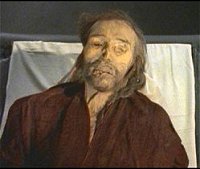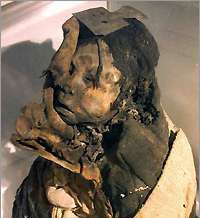                                        
|


Anthropology
3969/5969-1 (11370; 11371); 396-1
University
of Utah - Spring Semester 2009
Dr.
Ewa Wasilewska |
|
 |
COURSE OUTLINE
| Instructor: |
Dr.
Ewa Wasilewska |
| Office
hours: |
By
appointment only; please call the Department of Anthropology (581-6251)
and leave your name, phone number, and class number. email: mruczek@aol.com |
| Time: |
Each
Thursday at 2:00 p.m. to 5:00 p.m. |
| Location: |
Campus OSH 107
|
| Important
dates: |
Jan.21,
2009 – last day to drop classes
Jan.
26, 2009 – last day to elect CR/NC option or to audit classes
March 6, 2009 – last day to withdraw from term length classes |
| Required
Texts: |
All required articles/chapters (in chronological order) are to be found at the Reserve Desk at Marriott Library. Please check electronic reserve by Marriott Library first.
All articles/chapters are listed below as the required reading for specific weeks.
|
| Subject: |
This
course is designed to introduce students to various forms of mummification
and their underlying beliefs and rituals as resulting from specific perceptions
of death in world cultures. In addition to the discussion of both ancient
and modern customs of body preservation, common perception of mummies as
reflected by feature films will be presented. |
| Requirements: |
UNDERGRADUATE
STUDENTS
The
final grade will be based on three exams. Exams will consist of different
sections (including essay questions) especially designed for the type of
material, which will be covered during class meetings. In order to
pass these exams it is necessary to attend lectures and to read the required
material. Since the amount of information to which students will be exposed
is significant, three extra review sessions are planned after the last
session before each exam, after the regular class period. The most important
information, names, terms, definitions, etc., can be found in the notes
prepared by the instructor in order to structure the learning process in
the most effective way. At the end of the semester each student will be
required to turn in a research paper (10-12 pages plus bibliography) on
the topic of mummification, whether ancient or modern.
GRADUATE
STUDENTS
In
addition to the requirements listed above, graduate students are required
to write an additional research paper of ca. 20 pages (plus bibliography).
Each topic must be discussed with the instructor first and at the end of
the semester each graduate student might be asked to present a brief summary
of his or her research to the class. |
..
Week
# 1 - January 15, 2009
| Introduction
to the course. “Mummy fever”: Mummies in film and popular culture.
Movie:
"The Mummy". 1932 (72 minutes) V- Cass PN 1997 M85 1985.
“The
Mummy’s Tomb” 1942; PN1997 M81518 1992; the beginning of the movie to narrate
the previous movie (“The
Mummy’s Hand” 1940; PN1997 M8515 1992).
Readings
for Week # 1:
Cowie, Susan D. & Tom Johnson: The Mummy in Film, Television and Stage Production. In "The Mummy in Fact, Fiction and Film." McFarland & Company, Inc. Publishers. Jefferson, North Carolina, and London. 2002. Pp. 57-140.
http://www.egyptomania.org/ as an example of Egyptomania.
Assignment: Select at least three feature movies about mummies
(but
not the ones watched in class) and do their review (not description). |
 |
Week
# 2 - January 22, 2009
| Death, rituals, and mummification.
Readings
for Week #2:
Colman, Penny: P:
What Happens to Corpses: Decomposition, Transplants, Autopsies, and Embalming. In "Corpses, Coffins, and Crypts. A History of Burial." Henry Holt and Company. New York. 1997. Pp. 43-59.
Colman, Penny: P:
Bones and Ashes: Cremation and Other Ways to Dispose of Corpses.. In "Corpses, Coffins, and Crypts. A History of Burial." Henry Holt and Company. New York. 1997. Pp. 61-73.
Davies, Douglas J.: Interpreting Death Rites. In "death, Ritual and Belief. The Rhetoric of Funerary Rites." Continuum. London. New York. 2002. Pp. 1-23.
Pearson, Mike Parker: Learning From the Dead. In "The Archaeology of death and Burial." Texas A&M University Press College Station. 2000. PP.1-20.
|
.... .... .... |
|
Week
# 3 - January 29, 2009
Mummies
of Ancient Egypt. Part I.
Movie: "Egypt
Uncovered: Vol. 5. Mummies: Into the Afterlife. “ 2001. Bethesda, MD. 51
min. DT61 E336 1998 V.5
Readings
for Weeks # 3 -5:
Dunand, Françoise & Roger Lichtenberg: Introduction. Chapter1: From Prehistory to the First Two Dynasties. Chapter 2: The Old Kingdon. Chapter 3: The Middle Kingdom. Chapter 4: The New Kingdom. Chapter 6: The Passage from This Life to the Next. Chapter 8: Animal Mummies. In "Mummies and Death in Egypt." Cornell University Press. 2006. Pp. 1-58. Pp. 94-122. |
.. |
|
Week
# 4 - February 5, 2009
Mummies
of Ancient Egypt. Part II.
REVIEW!!! |
 ....... ....... |
|
Week
# 5 - February 12, 2009
Week
# 6 - February 19, 2009
| The
Tarim Basin mummies. Part 1.
Movie: “Mysterious
Mummies of China” (Nova) (60 minutes) 1998; V-Cass DS 719 M96 1998.
Readings
for Weeks #6 & 7:
E.W.:
H. # 6-7
Reid, Howard: Chapter 1: Central Asia: The riddle in the sands. In "In Search of the Immortals." St. Martin's Press: New York. 2001. Pp. 13-47.
Pringle, Heather: Invaders From the West. In "The Mummy Congress: Science, obsession, and the everlasting dead." New York 2001. Pp. 133-161. |
 .. .. |
|
Week
# 7 - February 26, 2009
The
Tarim Basin mummies. Part 2.
|
|
Week
# 8 - March 5, 2009
Ice
Mummies of Siberia. Part I.
Movies: A series of (180 min. total) produced by Nova entitled ”Ice Mummies:” 2. Siberian Ice Maiden.; Marriott
Library: V-Cass GN 293 128 1998 v. 1-3.
Readings
for Weeks #8 & 9:
E.W.:
H. # 8-9
Pearson, Mike Parker: The Frozen Tombs of Pazyryk: The body's skin as sacred boundary. In "The Archaeology of Death and Burial." Texas A&M University Press College Station. 2000. Pp. 61-67.
Chamberlain Andrew T. & Michael Parker Pearson: The Tattooed Horseriders of the Steppes. In "Earthly Remains: The History and Science of Preserved Human Bodies." Oxford University Press: 2001. Pp. 133-142.
Reid Howard: Chapter 2. Siberia: Ice mummies of the nomads. In "In Search of the Immortals." St. Martin's Press: New York. 2001. Pp. 49-78.
|
|
Week
# 9 - March 12, 2009
Ice Mummies of Siberia.
Part II.
Week
# 10 - March 19, 2009
SPRING BREAK !!!
Week
# 11 - March 26, 2009
| Bog
Mummies of Northwestern Europe.
Movie: Ewa's collection. "Bog Mummies." Travel Chanel.
Readings
for Week #10, 11 &12:
Chamberlain Andrew T. & Michael Parker Pearson: Cahpter 2: Bog Bodies. In "Earthly Remains: The History and Science of Preserved Human Bodies." Oxford University Press: 2001. Pp. 45-82.
Pearson, Mike Parker: Bog Bodies: Human sacrifices or social outcasts. In "The Archaeology of Death and Burial." Texas A&M University Press College Station. 2000. Pp. 67-71.
Review
!!!
|
|
|
Week
# 12 - April 2, 2009
Week
# 13 - April 9, 2009
| Chile
and Peru: The oldest mummies.
Movie: “The
Oldest Mummies in the World,” 2001. Beverly Hills, Ca.:; World Almanac
Video. 50 min. V-Cass F 2069 043 2001.
Readings
for Week 13:
Pringle, Heather: Children. In "The Mummy Congress: Science, obsession, and the everlasting dead." New York 2001. Pp. 293-317.
Reid Howard: Chapter 7. Coastal Chile and Peru: The first mummy makers. In "In Search of the Immortals." St. Martin's Press: New York. 2001. Pp. 189-208. |
|
Week
# 14 - April 16, 2009
Mummies
of Coastal Peru.
The Sacred Mummies
of the Andes. Part 1 (movies).
Movies:“Cliff
Mummies of the Andes,” 2001. New York: A & E Television Networks. 50
min. V-Cass F 3429 C57 2001.
“Cliff
Mummies of the Andes Unwrapped.” 2001. New York: A & E Television Networks.
50 min. V-Cass F 3429 C574 2001.
“The
Desert Mummies of Peru.” 2000. Discovery Channel. (52 min.) V-Cass
F 3429 D48 2000 |
|
|
|
Readings
for Week 14 & 15:
Reid, Howard: Chapter 8: Coastal Peru: Valleys of the Dead. Chapter 9: Peruvian Andes: In the sacred mountains. In "In Search of the Immortals." St. Martin's Press. New York. 2001. Pp. 209-281. |
|
Week
# 15 - April 23, 2009
Mummies
of Coastal Peru.
The Sacred Mummies
of the Andes. Part 2.
Movies: a series of (180 min. total) produced by Nova entitled "Ice Mummies" (1. Frozen in Heaven.). Marriott Library: V-Cass GN 293 128 1998 v. 1-3.
Review!!!
|
 |
Week
# 16 - April 30, 2009
Week
# 17 - May 7, 2009
EXAM
!!!
Last day to turn
in your papers.
 IMPORTANT!!! IMPORTANT!!!
ACADEMIC MISCONDUCT
Please familiarize yourself with the University of Utah CODE OF STUDENT RIGHTS AND RESPONSIBILITIES (“STUDENT CODE”) at www.admin.utah.edu/ppmanual//8/8-10.html
The following is an excerpt from this CODE explaining specific actions, which won’t be tolerated in this class.
“2. “Academic misconduct” includes, but is not limited to, cheating, misrepresenting one's work, inappropriately collaborating, plagiarism, and fabrication or falsification of information, as defined further below. It also includes facilitating academic misconduct by intentionally helping or attempting to help another to commit an act of academic misconduct.
a. “Cheating” involves the unauthorized possession or use of information, materials, notes, study aids, or other devices in any academic exercise, or the unauthorized communication with another person during such an exercise. Common examples of cheating include, but are not limited to, copying from another student's examination, submitting work for an in-class exam that has been prepared in advance, violating rules governing the administration of exams, having another person take an exam, altering one's work after the work has been returned and before resubmitting it, or violating any rules relating to academic conduct of a course or program.
b. Misrepresenting one's work includes, but is not limited to, representing material prepared by another as one's own work, or submitting the same work in more than one course without prior permission of both faculty members.
c. “Plagiarism” means the intentional unacknowledged use or incorporation of any other person's work in, or as a basis for, one's own work offered for academic consideration or credit or for public presentation. Plagiarism includes, but is not limited to, representing as one's own, without attribution, any other individual’s words, phrasing, ideas, sequence of ideas, information or any other mode or content of expression.
d. “Fabrication” or “falsification” includes reporting experiments or measurements or statistical analyses never performed; manipulating or altering data or other manifestations of research to achieve a desired result; falsifying or misrepresenting background information, credentials or other academically relevant information; or selective reporting, including the deliberate suppression of conflicting or unwanted data. It does not include honest error or honest differences in interpretations or judgments of data and/or results.”
The following sanctions will be imposed in this class for a student engaging in academic misconduct:
1. A failing grade for the specific assignment, paper, exam, etc., without possibility to re-write it, re-take it, etc. This academic misconduct will be reported to the Chairman of the Department of Anthropology.
2. The second offense will be sanctioned with a failing grade for the whole course. In such a case, the following rule of the University of Utah CODE OF STUDENT RIGHTS AND RESPONSIBILITIES is applicable and will be followed: “If the faculty member imposes the sanction of a failing grade for the course, the faculty member shall, within ten (10) business days of imposing the sanction, notify in writing, the chair of the student’s home department and the senior vice president for academic affairs or senior vice president for health sciences, as appropriate, of the academic misconduct and the circumstances which the faculty member believes support the imposition of a failing grade.”
3. For more information concerning sanctions for academic misconduct (additional sanctions might be imposed) and your rights and procedures to appeal these sanctions please refer to the aforementioned CODE.
If you need more information and/or explanations please don’t hesitate to contact the instructor.
 |
|
DOWNLOAD THIS DOCUMENT
AS A PDF OR WORD
FILE |
Ewa
Wasilewska's Home Page |
|
                                         |

















































































